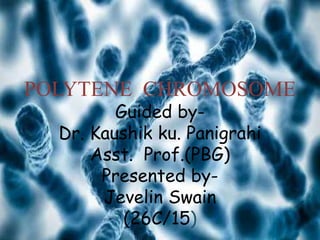
Presentation on Polytene Chromosome
- 1. POLYTENE CHROMOSOME Guided by- Dr. Kaushik ku. Panigrahi Asst. Prof.(PBG) Presented by- Jevelin Swain (26C/15)
- 2. INTRODUCTION • Polytene chromosome are giant chromosome common to many diptera flies. • First discovered by E.G Balbiani in 1881 , in of salivary glands , giving them the commonly used name salivary gland chromosome. • These are somatically paired. • The number of giant chromosome in salivery gland cell always appear to be half that in normal somatic cell.
- 3. • They are occur in rectal epithelium and malphigian tubules. • They are many larger than the normal chromosomes reaching a length of 200 micrometre and are visible even under a compound microscope.
- 4. • Because of these chromosome actually consist of many strands , they are called as polytene chromosome. • Polytene chromosome are oversized chromosomes which have developed from standard chromosome . • Specialised cells undergo repeated rounds of DNA replication without cell division , to increase cell volume , forming a polytene chromosome and the condition is described as Polyteny.
- 5. MORPHOLOGY • The larger size of chromosome is due to presence of many longitudinals strands called chromonemata. • The many strands of giant chromosome is due to repeated division of chromosome without cytoplasmic division (Endomitosis). • The polytene chromosome contains two type of bands namely dark band(80% DNA) and interband (15% DNA).
- 6. • The dark bands are darkly strained and inter bands are lightly stained with nuclear stains. • The dark bands contain more DNA and less RNA. • The bands of polytene chromosome become enlarged at certain times to form swelling called puffs. • The formation of puffs is called puffing.
- 8. • In regions of puffs , the chromonemata uncoil and open out to form many loops. • The puffs indicate the sites of active genes when m RNA synthesis takes place. • Intensely stained chromosomal segments correspond to high degree of packing and are generally inactive (Heterochromatin). • Less tightly packed segmented stain less distinctly with genetic activity(Euchromatin).
- 9. • In Drosophila , 5000 bands have been found in the 4 chromosomes of salivary gland cells. • Chromosomes in bands are at right angles to the long axis of chromosome. • Bands have high DNA content and absorb U.V light. • Contain 5 long arm and 1 short arm radiating from a central point called chromocentre , formed by the fusion of of all the 8 chromosome found in the cell.
- 10. • The short arm radiating from the chromocentre represents chromosome IV, one of the long chromosome is due to X chromosome , while the remaining 4 long arms represent the arms of chromosome II and III.
- 12. FUNCTION • In addition to increasing the volume of the cells nuclei and causing cell expansion , polytene cells may also have metabolic advantage as multiple copies of genes permits a high level of gene expression. • In Drosophilla melanogaster, the chromosomes of the larval salivary glands under many rounds of endoreduplication, to produce large amount of glue before pupation.
